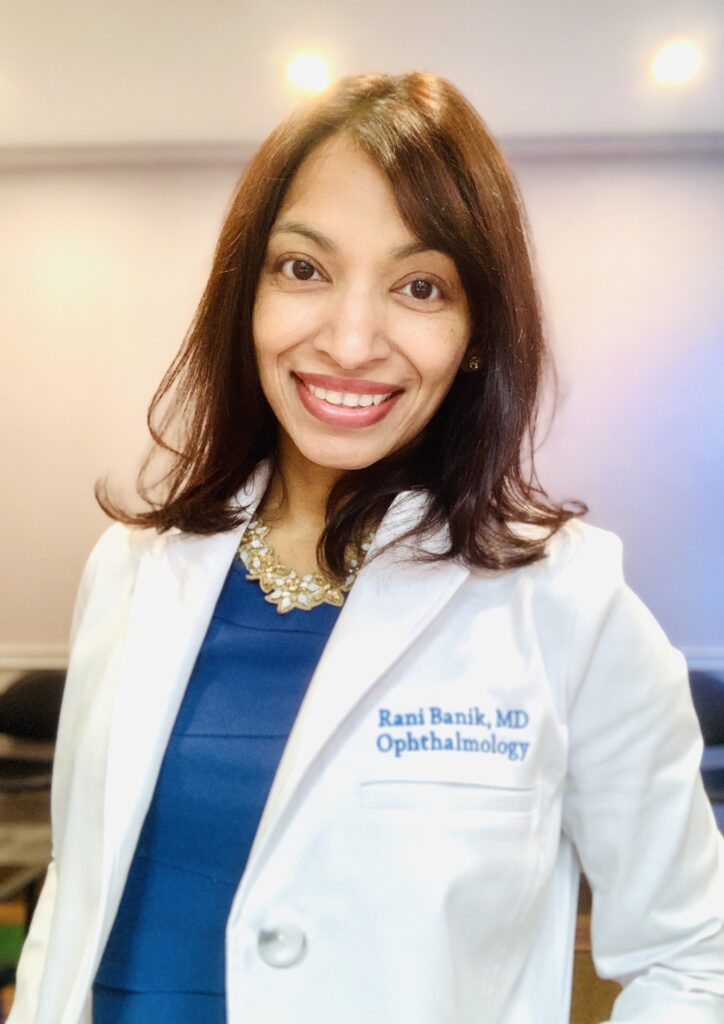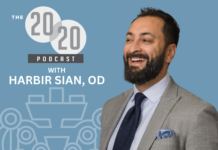Podcast: Play in new window | Download
Subscribe: Apple Podcasts | Google Podcasts | Spotify | Amazon Music | Android | RSS
Ocular nutrition is essential because it plays a crucial role in maintaining the health and function of the eyes. The eyes are complex organs requiring specific nutrients to support their structures and processes. Many individuals are unaware of nutrition’s significant role in maintaining eye health. By discussing ocular nutrition, eye care professionals can educate their patients about the importance of a healthy diet and how specific nutrients can benefit their eyes. This empowers patients to make informed decisions about their diet and lifestyle to support their eye health. Explore the transformative power of nutrition in promoting eye health in this riveting podcast with Dr. Darryl Glover and Dr. Rudrani Banik. Unpack the role of diet in combating common and severe eye conditions, and uncover practical tips for nurturing ocular wellness through balanced nutrition.
Key Objectives
Who is Dr. Rudrani Banik?

Dr. Rani Banik, known as America’s Integrative Eye Doctor, is a board-certified ophthalmologist and neuro-ophthalmologist with training in Integrative and Functional Medicine. She specializes in treating eye diseases like dry eye, thyroid eye disease, macular degeneration, cataract, glaucoma, and autoimmune visual system disorders. Dr. Rani’s approach encompasses nutrition, botanicals, lifestyle changes, essential oils, and supplements.
Based in New York City, Dr. Rani runs a private practice and is an Associate Professor at Mount Sinai, NYC, focusing on education and research. She’s a Principal Investigator in clinical trials exploring advanced treatments like nanotechnology and gene therapy for optic nerve diseases.
Dr. Rani is a recognized media expert, appearing on major networks and publications, and has been consistently named Top Doctor by Castle Connolly and New York Magazine since 2017.
Her acclaimed book, “Beyond Carrots – Best Foods For Eye Health A to Z,” highlights over 30 nutrients and 40 foods for eye health, winning praise in ophthalmology and integrative medicine. The accompanying cookbook, “The Beyond Carrots Cookbook,” features over 160 eye-healthy recipes. Both are available on Amazon in print and eBook formats.
Kickstarting the Conversation on Eye Nutrition
Dr. Darryl Glover:
Nutrient needs for the eyes, I’ve got it. Delicious recipes for the eyes, I’ve got it. Tune into today’s podcast. We have an amazing show in store for you. It’s all about nutrition, eye nutrition 101, baby. Let’s get started. It’s all about you today. So if you don’t mind, please share your background.
Dr. Rudrani Banik:
Absolutely, I’d love to. I’m a New Yorker, born and raised just north of the city. I went to medical school without a clear idea of the field I wanted to specialize in, but I gravitated toward ophthalmology. Yet, I also had a keen interest in neurology, making the decision quite challenging.
Ultimately, I chose ophthalmology because it’s about the eyes! What could be more fascinating than eyes, right? It’s a small yet incredibly complex organ, an essential part of our lives. So, I dove into ophthalmology, and during my residency in California, I pondered whether to opt for comprehensive ophthalmology training or pursue a fellowship.
Intriguingly, my love for neurology led me to a fellowship in neuro-ophthalmology. After traveling around the country for my training, I moved back to New York and joined the faculty at Albert Einstein in the Bronx.
However, my career took a turn when I started suffering from severe migraines. I had experienced migraines before, but they got so bad that I woke up with stabbing headaches every day. As someone who has had a migraine knows, it’s not a pleasant experience. Despite trying various medications, nothing seemed to alleviate the pain.
Finally, I had to take matters into my own hands. I turned towards more holistic therapies, including dietary supplements, lifestyle changes, and diet modifications. It was then that I realized the power of these natural strategies. Despite having seen numerous doctors, not one neurologist ever discussed my diet. Meanwhile, I was living off pizza, ice cream, diet soda, and consuming eight to twelve caffeinated drinks daily. It had never occurred to me that my dietary choices could be the root cause of these debilitating headaches.
However, my health drastically improved once I adjusted my lifestyle and diet. I began to incorporate these strategies into my patients’ treatments, those suffering from migraines and eye issues.
Diving Deep into Nutrient Needs for the Eye
Dr. Darryl Glover:
What I’d like to kick off our conversation with today is the nutritional needs of the eye.
Dr. Rudrani Banik:
My training touched on macronutrients and vitamin C’s role in preventing scurvy, but largely overlooked the broader impact of nutrition on health, a gap I later recognized as crucial, particularly for eye health.
Discussions on eye health often focus on macular carotenoids, lutein, and xanthin, known for their role in macular degeneration. Beyond that, they are potent antioxidants, located in the fovea, the most light-sensitive part of the eye. Increasing lutein and xanthin is vital in our high screen-time world.
Patients frequently inquire about blue-blocking glasses. I suggest enhancing the eyes’ natural defenses with nutrient-rich foods first.
Beta-carotene, aiding in vitamin A production and night vision, and omega-3 fatty acids, are also essential. The Women’s Health Study highlights omega-3’s benefits for dry eye and macular degeneration. DHA and EPA, omega-3 types, are crucial for the retina and photoreceptor health.
Bioflavonoids and polyphenols, lesser-known plant compounds, offer protection against oxidative stress and have shown potential in treating various eye conditions. The most studied for eye health include cetin, found in cherries, red onions, and apple skins, and resveratrol, in red wine and grapes.
In summary, a diverse plant-rich diet provides essential vitamins, minerals, and protective compounds. As eye care professionals, we must expand our nutritional knowledge and guide our patients in this area, meeting their growing interest and bridging the knowledge gap left by traditional training.
Simplifying the Start towards Better Nutrition
Dr. Darryl Glover:
That sounds like a really practical way to get started, and I think that’s what a lot of people struggle with. It’s like, okay, I want to make this change, but where do I begin? It can seem so overwhelming. Your suggestion of a green smoothie is a great place to start.
Let’s talk about, um, like a big issue like diabetes. It’s very common. How does diet factor in with diabetic eye disease, and what advice would you give to those patients?
Dr. Rudrani Banik:
Absolutely. So with diabetes, it’s a huge problem. And the first thing I tell patients is, we’ve got to control your blood sugar levels. The key to that is diet. It’s about limiting the intake of processed foods, refined carbohydrates, and sugary drinks, which all lead to spikes in blood sugar levels.
I tell my patients with diabetes that one of the best things they can do for their eyes is to adopt a diet rich in whole foods, particularly plants. This isn’t just good for controlling blood sugar levels. Whole foods are packed with the nutrients our eyes need to stay healthy, like vitamins A, C, and E, lutein, and omega-3 fatty acids.
And, I think it’s important to note, it’s not just about avoiding certain foods. It’s also about incorporating beneficial foods. For example, foods high in fiber can help regulate blood sugar levels, and foods high in omega-3s can reduce inflammation, which is often elevated in people with diabetes.But again, it’s about starting small. Incorporate one change at a time, like starting the day with a green smoothie, or swapping out a sugary afternoon snack for a handful of nuts or a piece of fruit. And of course, regular exercise and maintaining a healthy weight are crucial as well.
We also cannot stress enough the importance of regular eye exams to catch and treat diabetic eye disease early. All these steps, combined with the necessary medical care, can help protect the vision of people with diabetes.
Understanding Healthy vs. Unhealthy Fats
Dr. Darryl Glover:
I love how you’re connecting the dots for people, not just suggesting a specific supplement, but emphasizing the importance of a balanced, diverse diet and how that positively affects different areas of our health.
As we’re talking about diet, nutrition, gut health, and eye health, what’s your take on fats? We often hear about healthy fats and unhealthy fats. Do you have any specific recommendations for your patients?
Dr. Rudrani Banik:
Yes !. Fat is a necessary part of our diet, and it’s important to understand the difference between healthy and unhealthy fats. Unhealthy fats, like trans fats and saturated fats, can lead to inflammation in the body and negatively impact eye health, especially conditions like macular degeneration.
On the other hand, healthy fats, particularly omega-3 fatty acids, can play a beneficial role in eye health. Omega-3s have been shown to help with dry eye syndrome, prevent macular degeneration, and even maintain optimal eye pressure, which is crucial for glaucoma patients.Sources of these healthy fats include foods like chia seeds, flaxseeds, hemp seeds, and walnuts. For non-vegetarians, fatty fish like salmon or sardines are good sources.
It’s important to note that dietary fat needs to be balanced with other nutrients. I recommend incorporating a variety of nutrient-dense foods for overall health and wellbeing, which in turn supports good eye health.Finally, it’s important to remember that individual dietary needs can vary greatly, so it’s crucial to consult with a healthcare provider before making significant changes to your diet.
Unmasking Migraines: The Dehydration Connection
Dr. Darryl Glover:
Why is dehydration a trigger for migraines?
Dr. Rudrani Banik:
What happens in a migraine is that the blood vessels in our brain are very sensitive to changes. So often, if there’s a trigger, whether it be dehydration, hunger, stress, or lack of sleep, they’ll constrict.
When the blood vessels constrict, many people may experience the visual aura of a migraine, which is the scintillating scotoma. As eye care providers, we see this all the time. Patients come in absolutely scared to death that they’re having a stroke because they have these zigzag lines in their vision.
That’s what we believe is happening. Initially, there’s a constriction, then an electrical change, and then the blood vessels dilate, leading to the headache. One of the biggest triggers for this constriction is dehydration.
Hydration Hacks for Optimal Health
Dr. Darryl Glover:
So the next question is, how much water should you tell your patients to drink?
Dr. Rudrani Banik:
Let’s get into it. I believe hydration needs should be personalized based on the patient’s body weight. For example, someone who weighs 120 pounds doesn’t have the same hydration requirements as someone who weighs 250 pounds.What I tell patients is to take their weight in pounds, divide by two, and aim for that number of fluid ounces a day. However, there’s a limit to that. For instance, if someone weighs 160 pounds, they should aim for 80 fluid ounces a day.
And it doesn’t have to be only water. There’s a misconception that patients have to consume all their fluid intake from water. They can also consume other hydrating drinks, as long as they aren’t high in sugar or caffeinated, because caffeine can dehydrate you.Patients can also eat their water. There are many plants that are super hydrating and full of water content. If they’re having a big salad full of leafy greens or a fruit salad with water-dense fruits like cantaloupe and watermelon, they’re getting a lot of water from that. They can count that as part of their hydration requirement. Even tomatoes are highly hydrating. The other thing to remember is the importance of electrolytes.







